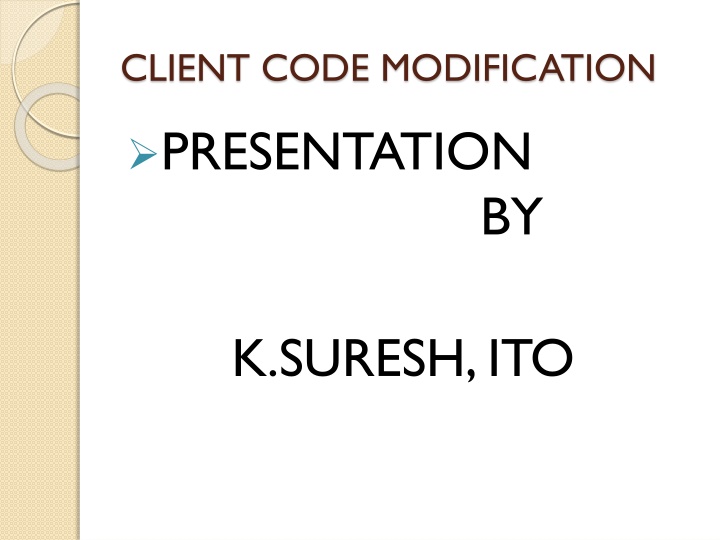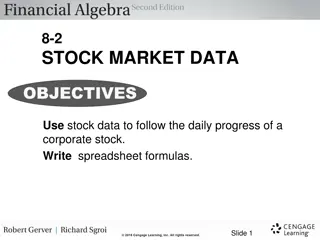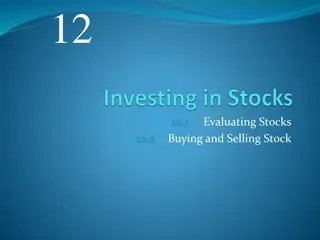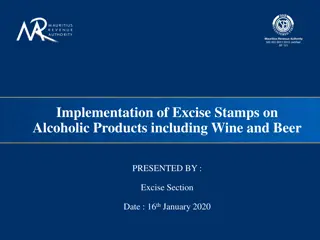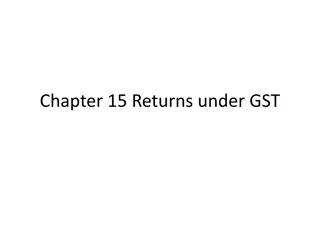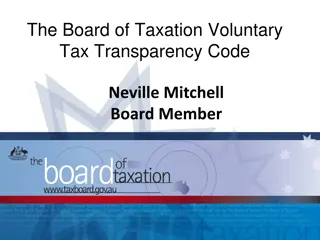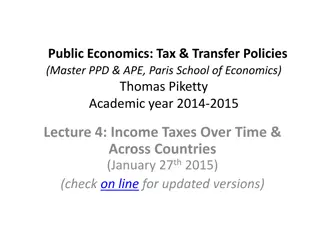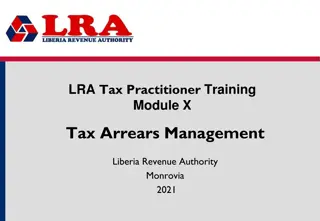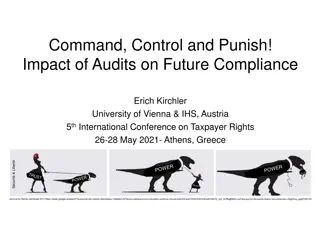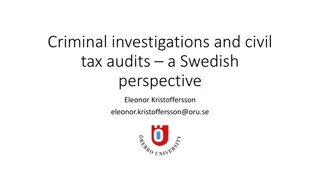Client Code Modification and Tax Evasion: Regulatory Issues in Stock Exchanges
Client Code Modification (CCM) is a service provided by Stock Exchanges to rectify errors in client codes during trading hours, but it has been misused for tax evasion by some brokers. Investigations revealed significant modifications leading to tax evasion. Regulatory bodies like SEBI and CBDT have issued orders and notifications to address these issues, emphasizing the importance of preventing code manipulations. Negligence in enforcing regulations by stock exchanges has been highlighted.
Download Presentation

Please find below an Image/Link to download the presentation.
The content on the website is provided AS IS for your information and personal use only. It may not be sold, licensed, or shared on other websites without obtaining consent from the author.If you encounter any issues during the download, it is possible that the publisher has removed the file from their server.
You are allowed to download the files provided on this website for personal or commercial use, subject to the condition that they are used lawfully. All files are the property of their respective owners.
The content on the website is provided AS IS for your information and personal use only. It may not be sold, licensed, or shared on other websites without obtaining consent from the author.
E N D
Presentation Transcript
CLIENT CODE MODIFICATION PRESENTATION BY K.SURESH, ITO
CLIENT CODE MODIFCATION (CCM) What is CCM ? Stock Exchanges provide a facility to modify client code to rectify any error or wrong data entry done by the stock brokers at the time of punching orders.
PURPOSE OF CLIENT CODE MODIFCATION CCM for rectifying genuine errors and mistakes that may have occurred during the trading hours. Admissible upto 30 mts after closing of trading hours. Applicable only in Intra day transactions.
MISUSE TO EVADE TAXES Some brokers transferred Trade gains or losses from one person to another by changing the client codes, in the garb of correcting an error. These gain or loss book entries were then used to evade taxes.
INVESTIGATIONS During Investigations by Income Tax Department and SEBI, it was found Client Code Modifications in excess of Rs 55,000 Crore were done by Brokers to evade Taxes.
CBDT NOTIFICATION CBDT Notification No 14/2011 dated 09/03/2011. As per Notification Stock Exchanges should ensure the transactions (Cash and F&O) once registered in the system are not erased. Stock Exchanges to furnish monthly statement in Form 6DDA) and Form No 3BC DDC). No 3 BB(Rule (Rule 6
SEBI ORDER SEBI PASSED ORDER IN RESPECT OF MODIFICATION OF CLIENT COES OF TRADERS VIDE WTM/PS/09/DNPD/ APRIL/2012 DATED 11/7/2011 AGAINST NATIONAL STOCK EXCHANGE (NSE) FOR VIOLATING THE PROCEDURES.
SEBIs ORDER ON NSE SEBI is of the opinion that the number of errors is a strong indicator whether the errors are genuine or not. If we contrast this to thousand of errors committed in a month in the case of modification of client code, it is but obvious that there would have been some other reason than genuine mistake. NSE has taken a laid back attitude towards the problem and either totally ignored or perfunctorily imposed minor penalties to the brokers. It failed to apply its mind to the unusualness of the happenings. I therefore find that NSE acted negligently in discharge of its regulatory duties.
SEBIs STATISTICS SEBI observed that the number of modified trades in the equity derivative segment increased from 3.85 lakhs in the month of January, 2010 to 6.80 lakh during March, 2010 i.e. an increase of 76.6%. The value of modified trades also increased from 35,968 crore in January, 2010 to 55,469 crore in March, 2010 (an increase of 54.2%).
UNUSUAL INCREASE IN CCM Similarly, the number of modified trades in currency derivative segment, has increased from 863 during January, 2010 to 19,395 in the month of March, 2010 showing an increase of 2,147%. The value of modified trades also increased from 461 crore in January, 2010 to 13,282 crore in March, 2010 i.e. an increase of 2,781%.
SEBIs Order THE modification of client codes is allowed to rectify inadvertent errors in punching the orders, as directed by SEBI vide Circular dated February 06, 2003, and hence such modifications are expected to be randomly distributed over months. Therefore, the number of modified orders should have remained more or less uniform across months with some deviations either to positive or negative side, under normal circumstances. However, the significant variation in the modification of client codes in the immediate months around March, 2010 as brought out gives rise to a genuine doubt whether the modifications have been carried out for purposes other than those to rectify genuine errors.
MODUS OPERANDI A What the Share Brokers actually Do??? A - wants to book a loss during March, 2010 i.e. end of F Y, as he has already having substantial taxable profits. B - wants to book profit through intra day transactions to earn Profits . CLIENT CODE OF A WITH THE SHARE BROKER (for example) is SJ 1234 CLIENT CODE OF B WITH THE SHARE BROKER (for example) is RK 4567
Bs Loss transferred to A A has not done any transaction during the day but expecting to book loss through broker by using other client code who incur loss. B buys 1000 shares of 'xyz ltd at Rs 100 a share thru a broker in anticipation that the price will go up. Due to volatile market, xyz ltd moves down to Rs 90 a share at the end of the closing hour. Broker modifies client code of A i.e. SJ 1234 against transaction done by B thru code RK 4567 within half an hour of closing of the day. B incurred loss of Rs 10,000/- intra day in sale/purchase of xyz ltd . Booked bogus Loss & set off against Profits ending up paying no Taxes. B even though incurred loss, end up receiving cash from A through Broker.
MODUS OPERANDI - B Imagine for a moment 2 clients A & B :- A - WANTS TO BOOK A LOSS (say for example he has already have sufficient Profits and wanted to close the Financial Year with paying less or no Taxes after setting off Profits against acquired Loss). B - WANTS TO BOOK A PROFIT. A buys stock 'xyz ltd.' from B at Rs 100 a share in anticipation that the price will drop to Rs 90. But instead the stock moves up to Rs 110. A ends up Profit of Rs 10 per share and B ends of Loss of Rs 10 per share at the end of the day. What the broker does then is to swap the 2 client codes by 4:15 pm - gifting 'A' a loss and 'B' a profit. Since on the exchange the trades have been squared, there are no delivery obligations.
TRANSFER OF LOSS TRADING GAIN/TRADING LOSSES WERE TRANSFERRED FROM ONE ACCOUNT (A) TO ANOTHER (B) OR VICE CERSA UNDER GUISE OF RECTIFYING ERRORS. MOST COMMON IN DERIVATIVES MARKET UNDER NATIONAL STOCK EXCHANGE (NSE).
WHEN & WHERE IT HAPPENS?? An assessee who has made profits during the year but has not paid any Taxes. At the end of the year, he believes that he has a huge tax liability as well as interest liability. He would take/buy loss with his cash unaccounted money from the person who shift their losses to him through share broker. He will end up setting off his profits against losses and end up paying NO Tax.
ASSESSMENT ????? WHAT THE ASSESSING OFFICER TO DO
STOCK EXCHANGE POLICY As per the policy, the modification (CCM) if any is not permitted across the board and the same is allowed with restrictions. Only the following types of modifications are permitted by NSE namely, (i) similarity of names and code numbers - non repetitive ones and (ii) family codes. Modifications are not permitted as a rule but only as exception to the rule.
ONUS ON THE ASSESSEE The assessee cannot simply distance himself from this major allegation by stating that the Client Modification is the internal matter of the Broker and assessee has no control.The fact that loss is transferred to assessee s code is to the benefit of the assessee who is setting off against Profits. Assessee being the beneficiary of the impugned loss and the claimer of the deduction by way of set off against the other income. Share Broker, who is party to such generation of loss, needs to demonstrate on what basis the client Codes are similar to that of the assessee as per the Stock Exchange Policy. Are the names similar? Are the changed clients are part of the assessee s family? Are the codes similar? These are the logical questions which are required to be answered by the claimer of the deduction (assessee) or generator of the impugned losses (Broker).
TAXABILITY The setting off of losses through client code modification is not the actual loss incurred by the assessee. Any setting off of such losses against profits is colourable device to evade taxes. The difference should be treated as suppressed profit of Assessee.
TAXABILITY The loss is a non-genuine and fictitious loss which has been acquired by the assessee in gross misuse of error entry modification with the tacit connivance of the Broker. The client code modification was being done in cases other than that for rectifying the genuine errors under the garb of existing practices to evade Taxes.
TRADE LOSS FROM CCM If Loss is claimed by the Assessee : - Whether the said modification to the Client Code was done with a mala fide intention to generate Trading loss by the assessee by the collusive arrangement with the broker ? If Yes, the Business Loss is to be disallowed and Profit to be Taxed without setting off with Trading Losses.
TRADE PROFIT FROM CCM If Profit is claimed by the assessee :- Whether the said modification to the client code was done with a mala fide intention to generate Trading Profit ? It is the situation where profit shifted from some of the clients by the broker through CCM to set off the brought forward losses available with the assessee. The Object of shifting of Profit is to introduce Undisclosed Money into the Capital in the garb of Profit from Trading. It is nothing but Introduction of Black Money into Capital which should be taxed as Income from Undisclosed Sources .
UNDISCLOSED PROFITS The profit arising out of the Client Code Modification transactions, where in client code was modified later, should be considered as the profit of the assessee and hence the same should be assessed in its hands as Income from Undisclosed Sources. Setting off of losses not to be allowed u/s 115 BBE of I T Act, 1961.
TRADING PROFIT / LOSS IF IF TRADING/CAPITAL PROFIT CLAIMED THRO UGH MODIFICATION IN CLIENTCODE TRADING/CAPITAL LOSS CLAIMED THROUGH MODIFICATION IN CLIENTCODE MODIFICATION SET OFF AGAINST PROFITS NOT TO BE ALLOWED BEING NOT ACTUAL LOSS SET OFF AGAINST LOSS NOT TO BE ALLOWED. TRADING LOSS/PROFIT IS NON GENUINE AND FICTIOUS, ACQUIRED WITH TACIT CONNIVANE OF SHARE BROKERS THROUGH CLIENT CODE MODIFICATIONS.
FRAMING OF ASSTT. ORDER RELEVANT INCOME TAX SECTIONS & FAVOURABLE JUDGMENTS
BUSINESS INCOME Section 43(5) of the Income Tax Act 1961:- speculative transaction means a transaction in which a contract for the purchase or sale of any commodity, including stocks and shares, is periodically or ultimately settled otherwise than by the actual delivery or transfer of the commodity or scrips: Provided that for the purposes of this clause (d) an eligible transaction in respect of trading in derivatives referred to in clause (ac) of section 2 of the Securities Contracts (Regulation) Act, 1956 (42 of 1956) carried out in a recognised stock exchange;76[or] [(e) an eligible transaction in respect of trading in commodity derivatives carried out in a recognised association [, which is chargeable to commodities transaction tax under Chapter VII of the Finance Act, 2013 (17 of 2013),]] shall not be deemed to be a speculative transaction.
SECTION 44 AB APPLICABLE Trading including commodity derivatives on a recognized stock exchange are considered as income. Normal rules for tax audit as stated in section 44AB will be applicable in case of F&O/Derivative trading also. Profits in derivatives normal business
McDowell & Co Ltd. Vs CTO 154 ITR 148 (SC) The landmark decision by Constitution Bench of Supreme Court in the case of McDowell & Co Ltd. Vs CTO 154 ITR 148 (SC) is squarely applicable. The modus operandi adopted by the assessees by acquiring Losses or acquiring Profits with tacit connivance with the Brokers thru Client Code Modifications without paying any taxes or avoid declaring true Profits is nothing but a colourable device as cited by Hon ble SC Judgment.
McDowell & Co Ltd.,-SC Relevant Para of the Judgment : 45. Tax planning may be legitimate provided it is within the framework of law. Colourable devices cannot be part of tax planning and it is wrong to encourage or entertain the belief that it is honourable to avoid the payment of tax by resorting to dubious methods. It is the obligation of every citizen to pay the taxes honestly without resorting to subterfuges.
SUPREME COURT JUDGMENT "The taxing authority is entitled and is indeed bound to determine the true legal relation resulting from a transaction. If the parties have chosen to conceal by a device the legal relation, it is open to the taxing authorities to unravel the device and to determine the true character of the relationship. Hon ble High Court of Delhi in the decision dated 19/11/2015 reported in ITA 130/2001 Commissioner of Income Tax Vs M/s Abhinandan Investment Ltd., followed the SC Judgment while upholding the action of the Assessing Officer in unraveling colourable device.
CIT Vs DURGA PRASAD Hon ble Supreme Court in the case of CIT vs. Durga Prasad More [1971] 82 ITR 540 (SC) and in the case of Sumati Dayal vs. CIT reported in 214 ITR 801 (SC) Held that the taxing authorities are required to put on the blinkers while looking at the documents produced before them. They are also entitled to look into the surrounding circumstances to find out the reality .. .
CIT Vs DLF COMMERCIAL DEVELOPERS LTD ITA No 94/2013 dated 11/7/2013 Profit from Trading in Derivatives is a Business Income u/s 43(5) of Act. But the Stock Derivative Loss is not allowed to be carried forward and set-off against business income. Can be carry forward and set off only against Speculative Income and not against Business Income.
DETAILS REQUIRED APPROACH BY ASSESSING OFFICER TO UNEARTH COLOURABLE DEVICE
PRELIMINARY DETAILS Preliminary Details to be called from the assessee :- Details of Share/Derivative/Multi Commodity or any other Trade Transaction during the year ________. Name and address of the Share Broker (s) through whom Transactions undertaken; Details of DematAccount and Trading Accounts maintained; Details of Client Code allotted to the assessee by the Broker(s); Ledger account copy with the Broker (s) for the year under consideration ; Contract Notes of Sale/Purchase of shares/derivatives etc., under taken through the Broker during the period _____________; Details of Payments Made to the Broker(s) during the year ; Details of Payments received from the Broker (s) during the year ; Whether Transaction with the Broker for the first time or he is a regular client, furnish complete details of the transactions ; Details of margin money paid to the broker with sources thereof; Frequency of Transaction ; Details of Transaction(s) during the year which involve Client Code Modification undertaken by the Broker; Reason for Client Code Modification; Details of Capital Gain or Capital Loss or Trade Profit or Trade Loss may be provided; The Gain/Loss involving Client Code Modification may be separately provided;
DETAILS TO BE OBTAINED FROM SHARE BROKER Details from Share Brokers in respect of assessee : Transaction ID Original Client Code Modified Client Code Name of the original client PAN of the original client Name of the modified client PAN of the modified client Scrip name Quantity of shares/scripts transacted through modification Rate of (9) above. Total Value of transaction Buy or sell Date of transaction
DETAILS TO BE OBTAINED FROM NSE & MCX Details of Client Code Modification of assessee for the period ___. Ledger account of assessee for all exchanges. Master summary of the above client for FY ________. Copies of KYC forms of the Client. Details as to who executed the transactions (broker details). Complete details of Original Client Code and Modified Client Code along with name and address of the persons/account holders involved may be provided. Quantity of shares/scripts transacted through modification, rates, total value of transactions entered into by assessee during the year. Details with amount of loss or gain transferred through Client Code Modification to assessee i.e. Client Code ____. The detailed data along with financial implications regarding the client code modifications for separate segments such as cash, equity derivatives, currency derivatives and all trades in respect of --------(assessee )____ (PAN)______ (client code).
ADDRESSES MEMBERS SERVICE MANAGEMENT (TRADE BACK OFFICE), NATIONAL STOCK EXCHANGE OF INDIA LTD., EXCHANGE PLAZA, C-1, BLOCK G, BANDRA KURLA COMPLEX, BANDRA (E), MUMBAI-400 051. Multi Commodity Exchange of India Ltd., Exchange Square, CST No.225, Suren Road, Andheri (E), Mumbai-400 093.
CONCLUSION INVESTIGATIONS BY INCOME TAX DEPARTMENT, SEBI, NSE, MCX FOUND MODIFICATION IN CLIENT CODE WAS DONE WITH A MALA FIDE INTENTION TO GENERATE NON GENUINE TRADING LOSS/PROFIT WITH THE OBJECT TO EVADE TAXES IN CONNIVANCE WITH SHARE BROKERS BY ABUSING MODIFICATIONS ALLOWED FOR RECTIFIYING GENUINE ERRORS.
DISCLAIMER Disclaimer :- The facts/interpretation is purely as per understanding of the subject and should not be taken as the final or official version. The Member may use such information for guidance and should independently verify the contents and facts on their own.
